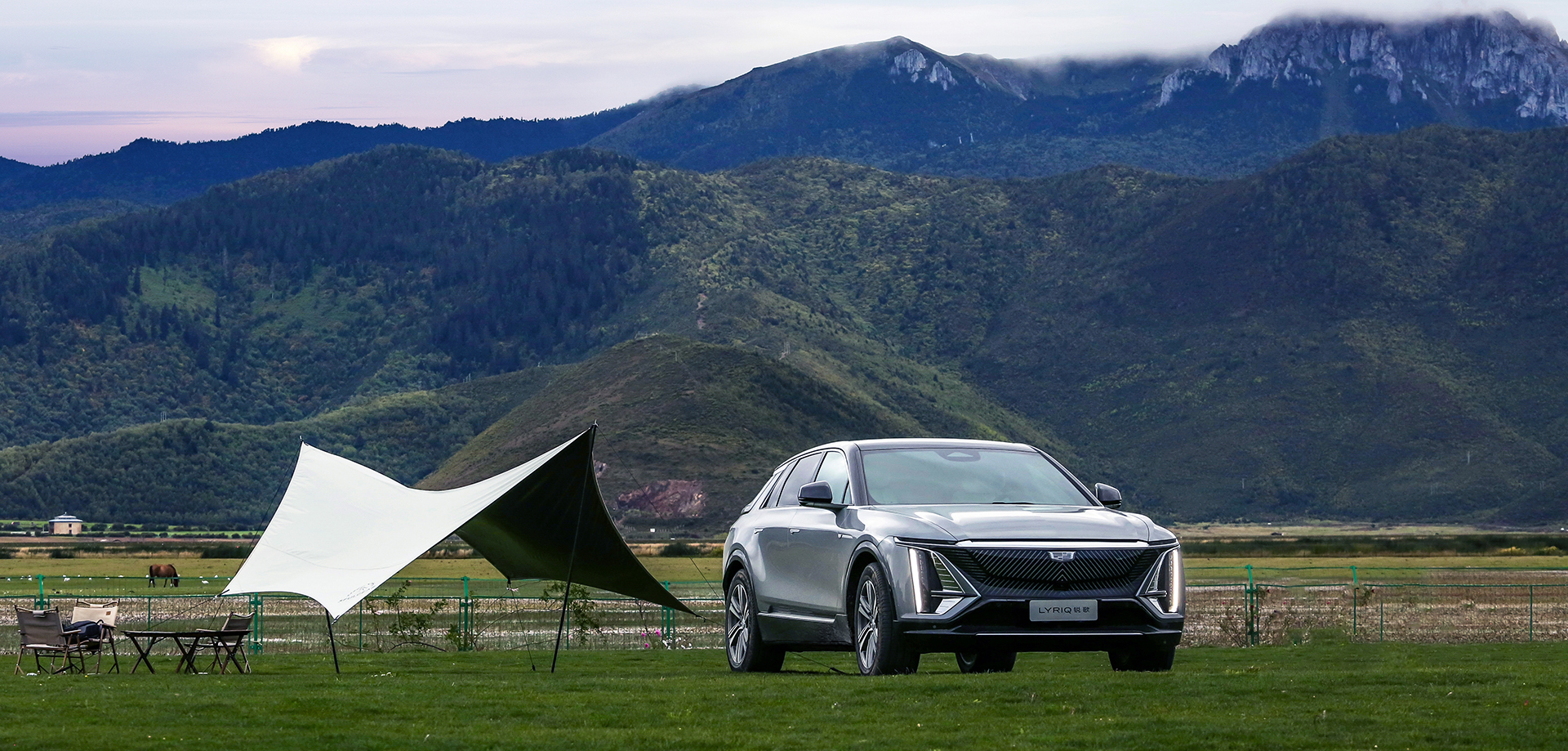LYRIQ, the first model of Cadillac’s Ultium platform, was officially released on November 17, 2021. Despite using a brand-new Ultium electric platform, you can still tell it’s a Cadillac from its appearance.
However, the LYRIQ, originally expected to be delivered in mid-2022, was still in the engineering car phase when I visited the shop to experience it last month.
So, with September coming to an end, is LYRIQ ready for delivery? I may have found the answer when I came to Shangri-La, Yunnan Province, for a test drive.
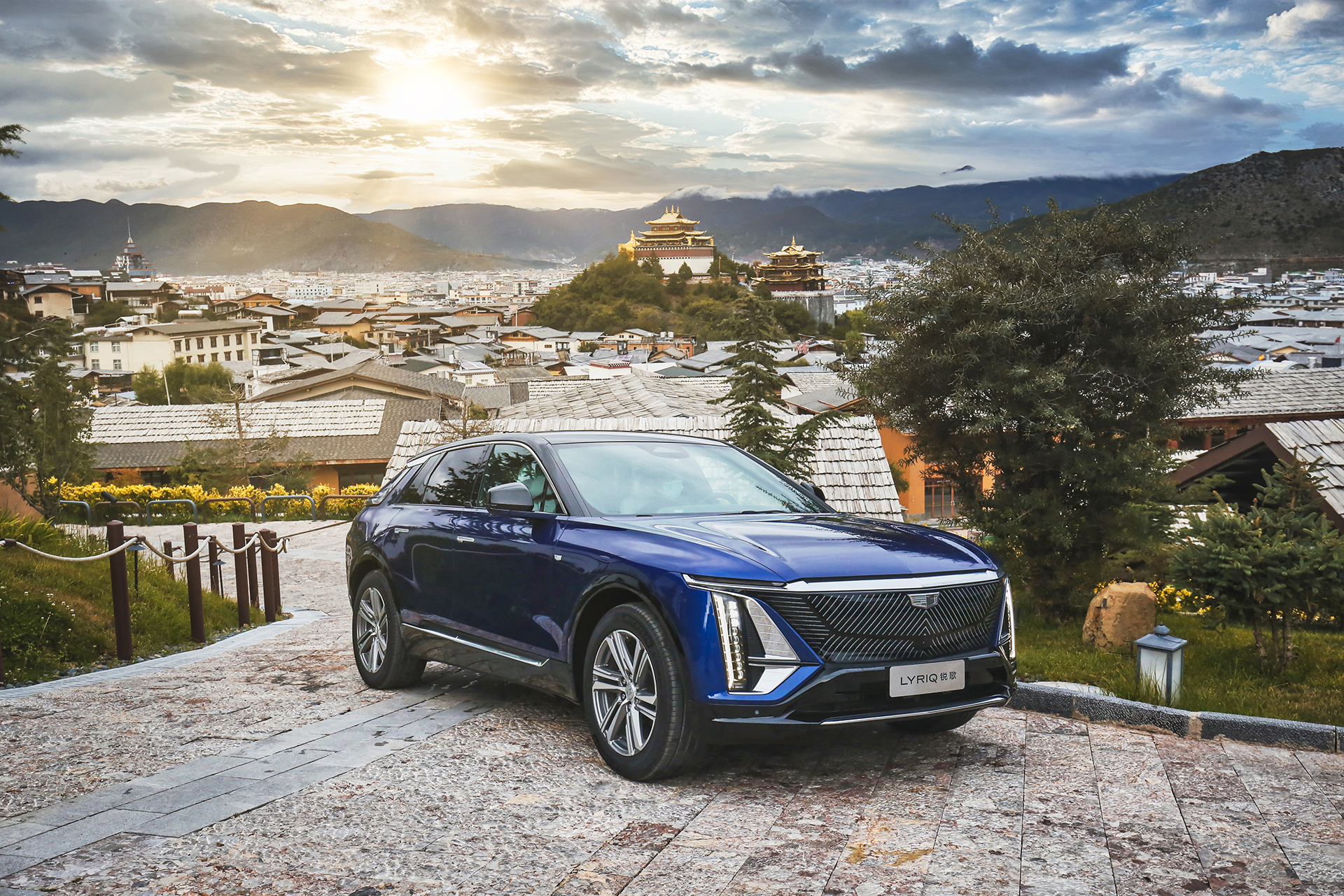
Static Performance
I believe many people have seen the static display cars at the store. Here, I would like to focus on the parts that I find particularly interesting, hoping that readers who have not experienced the actual car can go to the store to feel it after reading this.
Appearance
The front of the car still features the familiar design of the Cadillac family, but due to being an electric model, the original air intake grille has been changed to a closed design.

The illuminated grille is hidden inside the front grille and should look very nice when it lights up at night.

The daytime running lights and headlights are both placed on the left and right sides.

From the side, you can see that LYRIQ’s roof has a distinctly downward design starting from the driver’s head, which is also the reason why many people are concerned about the headroom in the rear row.

The tail of the car still features the familiar Cadillac style with sharp edges and corners, resembling the Cadillac shield logo.

LYRIQ does have a front trunk, but with only 35L capacity, it can only fit some drinks or items like backpacks, and can not hold luggage of the size of a suitcase.
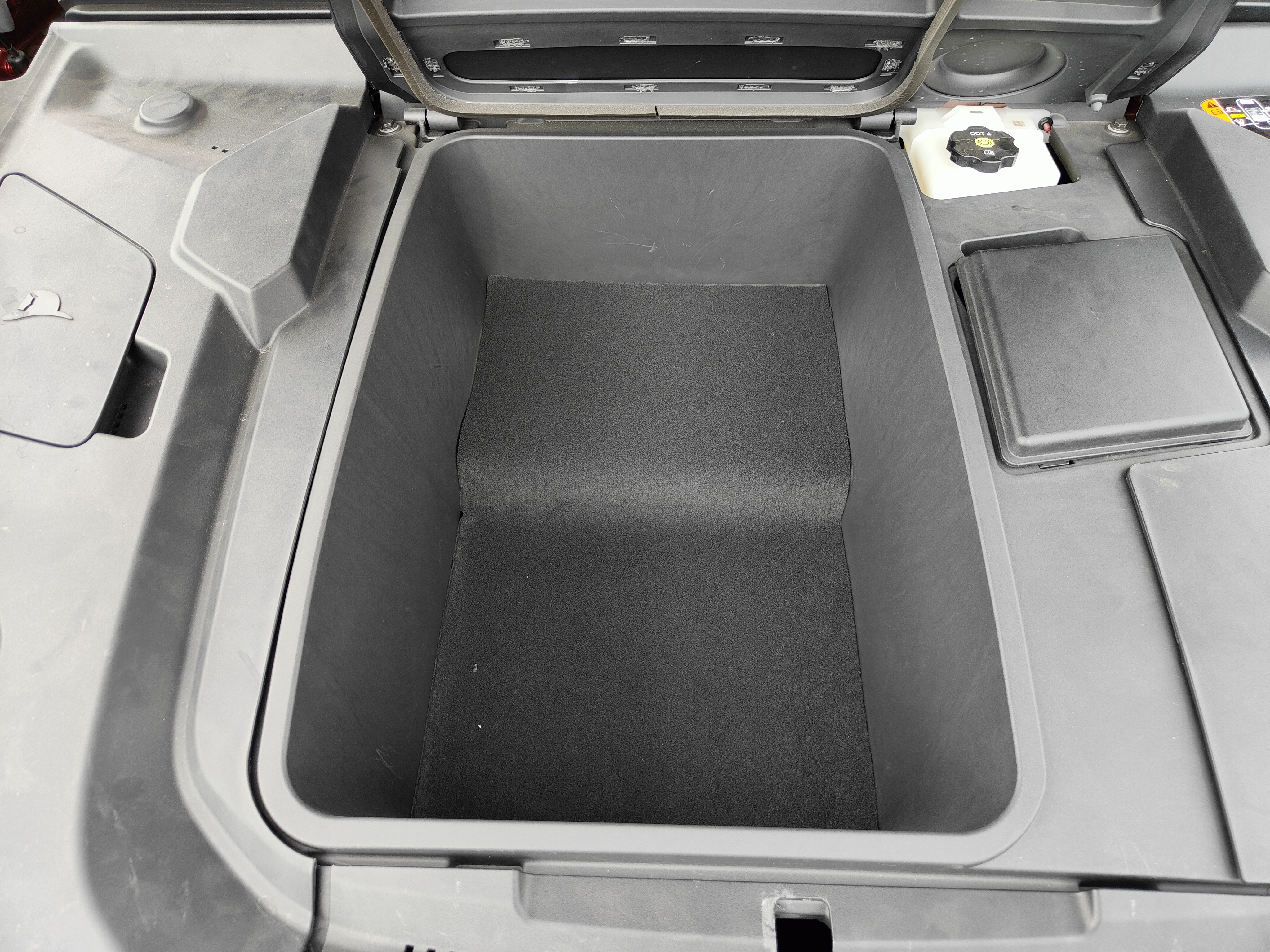 The good news is that the trunk has a capacity of 521L, which is spacious enough to accommodate quite a few daily items.
The good news is that the trunk has a capacity of 521L, which is spacious enough to accommodate quite a few daily items.

Folding down the rear seats can provide a storage space of 1549L.
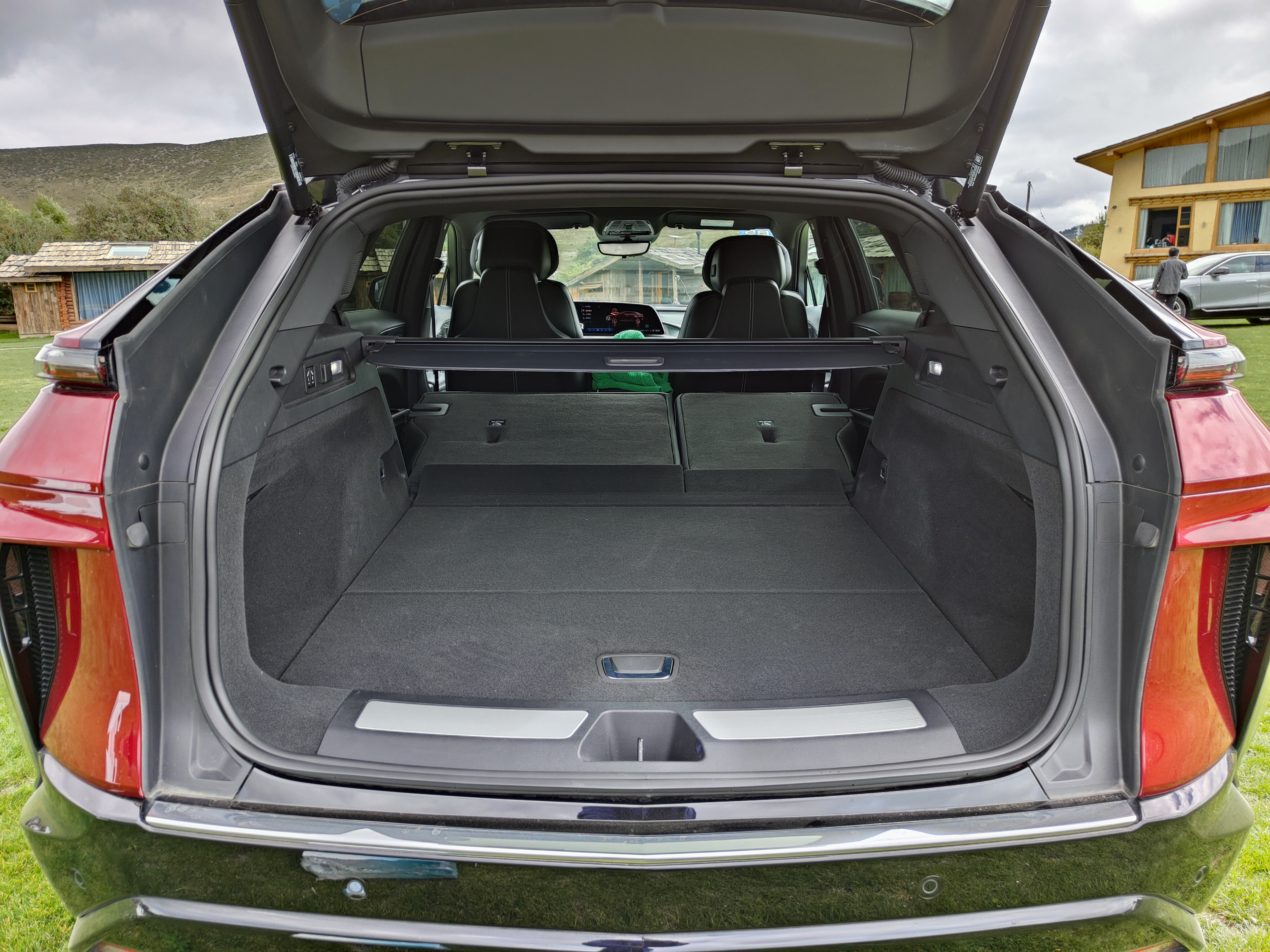
On the left side of the trunk, there is a button for folding down the rear seats, an external power outlet for car-mounted electrical appliances, and a lighting lamp.
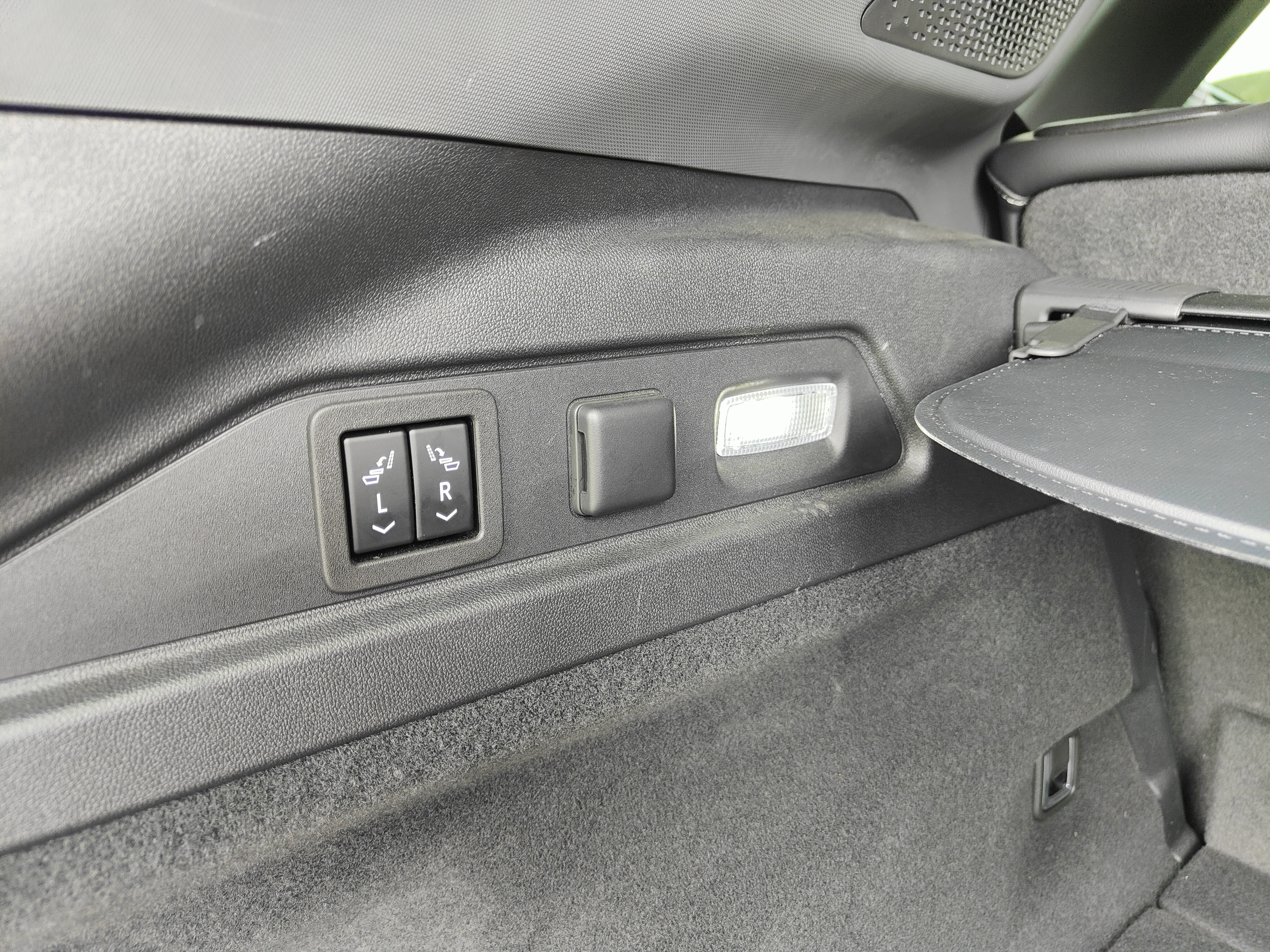
When opening the partition board of the trunk, there is a relatively deep storage compartment in the toolbox underneath, which can hold some small miscellaneous items.
As for the appearance, that’s all for now. The interior part is believed to be the focus of everyone’s attention, so let’s take a look.
Interior
I put the overall interior of the front row in the comparative section of competitors. Here, I will start with the details.
There’s nothing to say about the left gear lever section – it’s all conventional functions. What really needs to be mentioned is the small paddle behind the steering wheel.

This is not a paddle for shifting on a gasoline car, but a paddle for controlling vehicle kinetic energy recovery. This is the first time I’ve seen such a design, and actual user experience will be discussed in the dynamic section.
The right gear lever looks like an ordinary “park” gear, but it is not used in the same way. LYRIQ does not shift up and down directly by stepping on the brake pedal and pulling or pushing the gear lever. Instead, it needs to pull the gear lever back to the driver’s side, and then shift up and down. I personally think it is not as convenient as directly pulling up and down, and I suspect that Cadillac designed it to prevent accidental shifting.
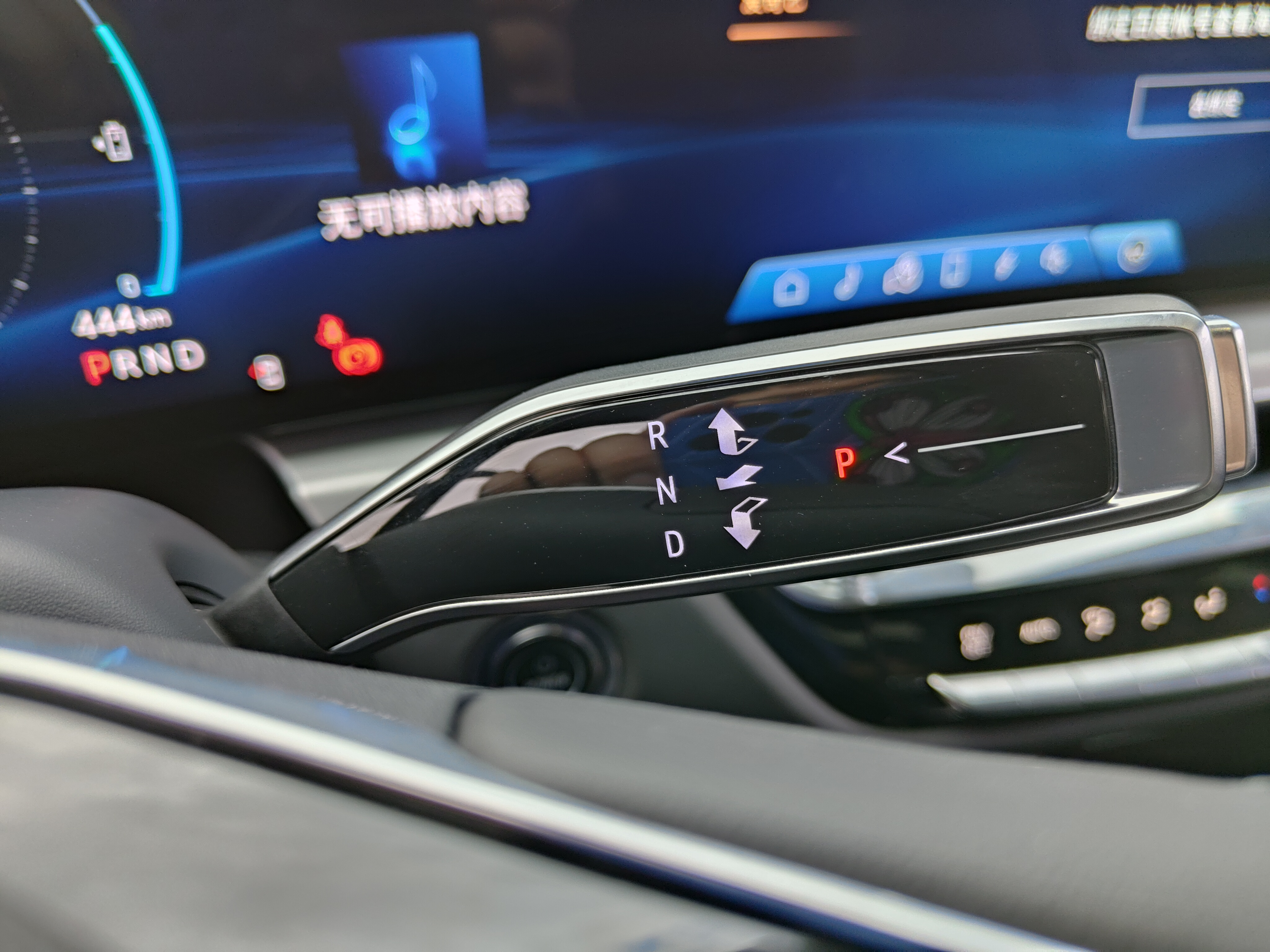
The various switches of the driver’s seat are placed on the door panel, which is indeed more intuitive to operate.
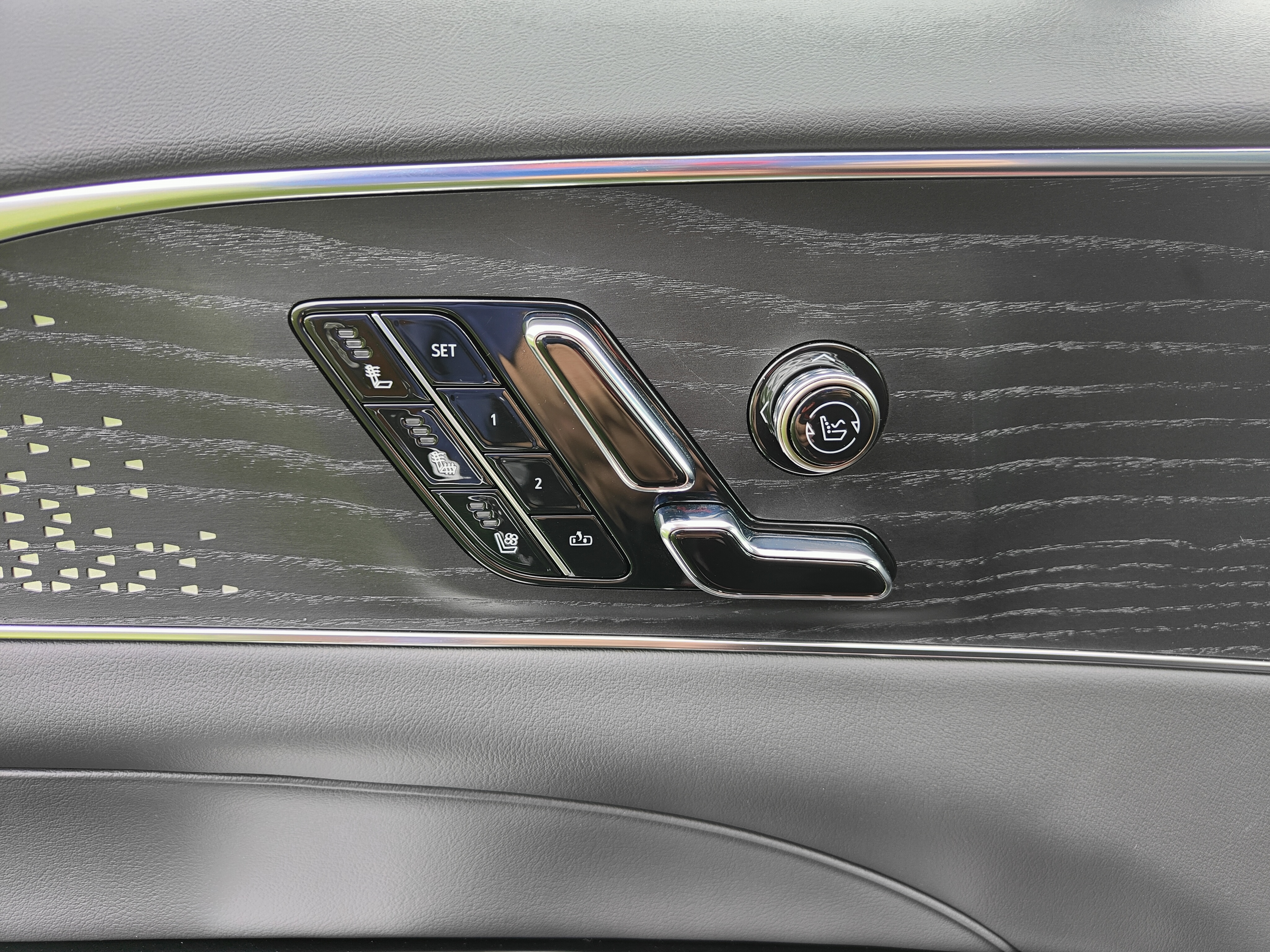
The densely packed triangles on the door panel are ambient lights, officially called “dappled shadows” ambient lights, which support 26-color display.

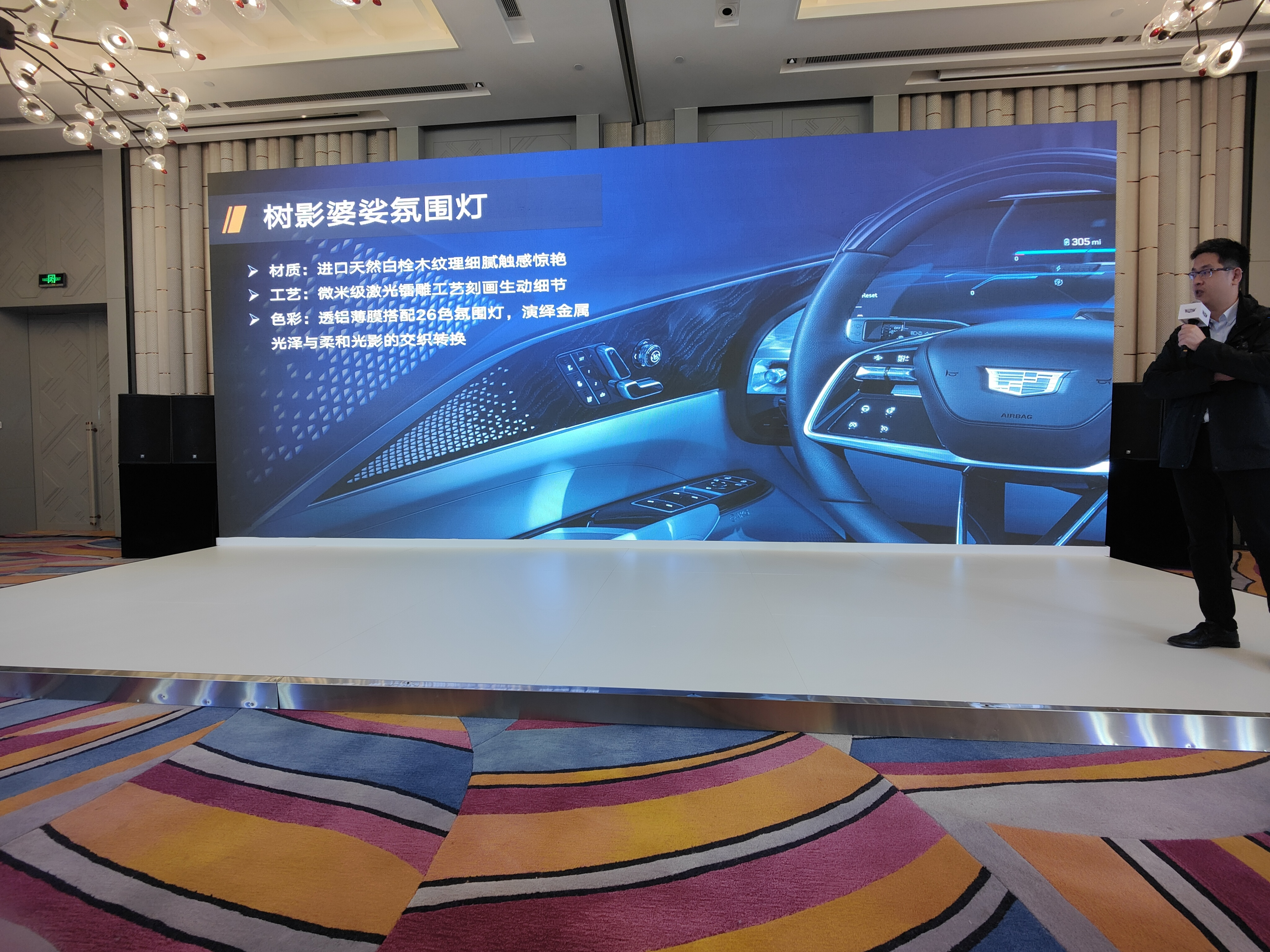
There is also the trunk opening button in the front of the driver’s door panel storage compartment, which is a relatively rare design.
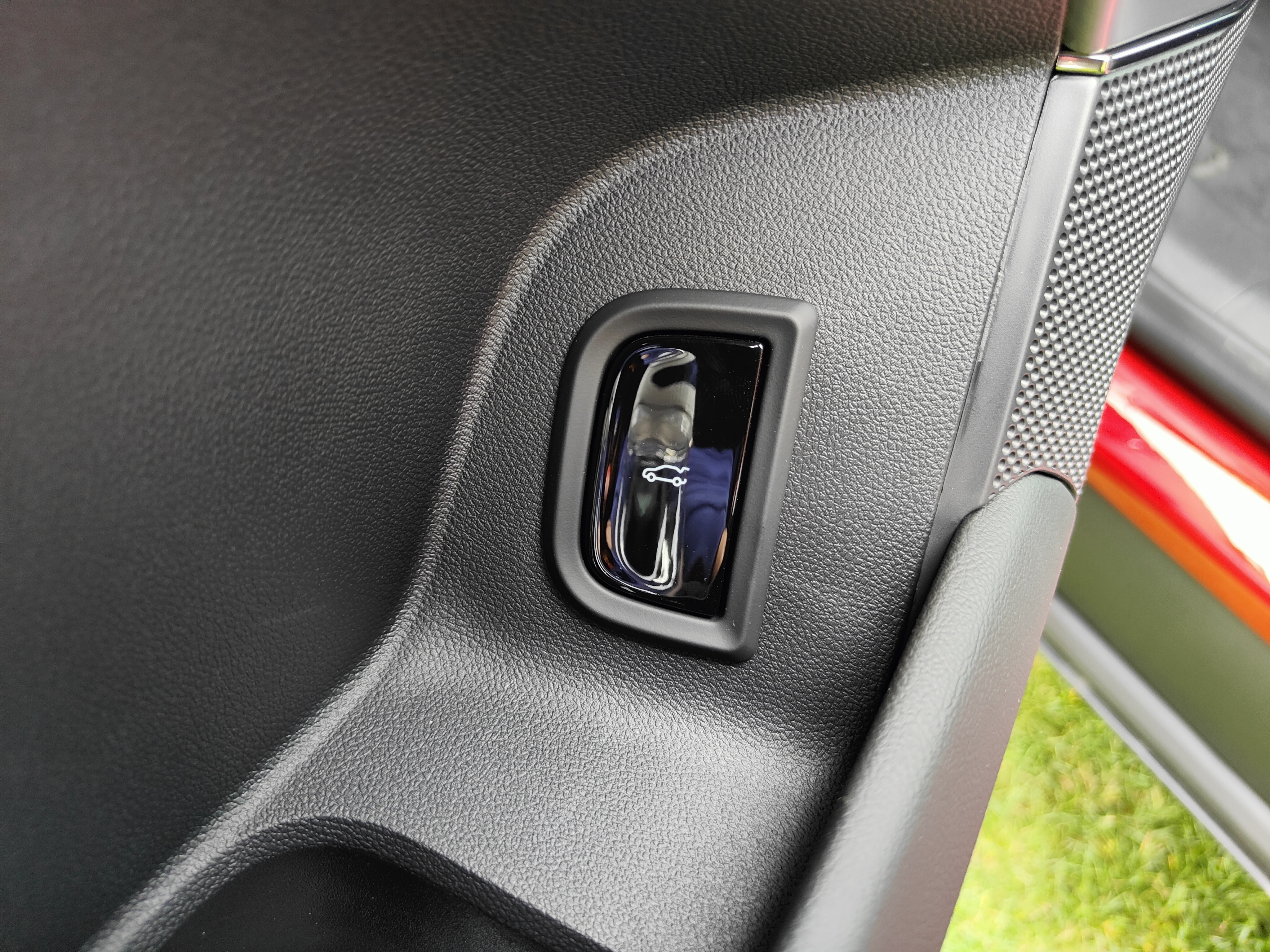
The speaker is a 19-speaker, 1,400-watt sound system in deep collaboration with AKG, and the actual listening experience is quite good.
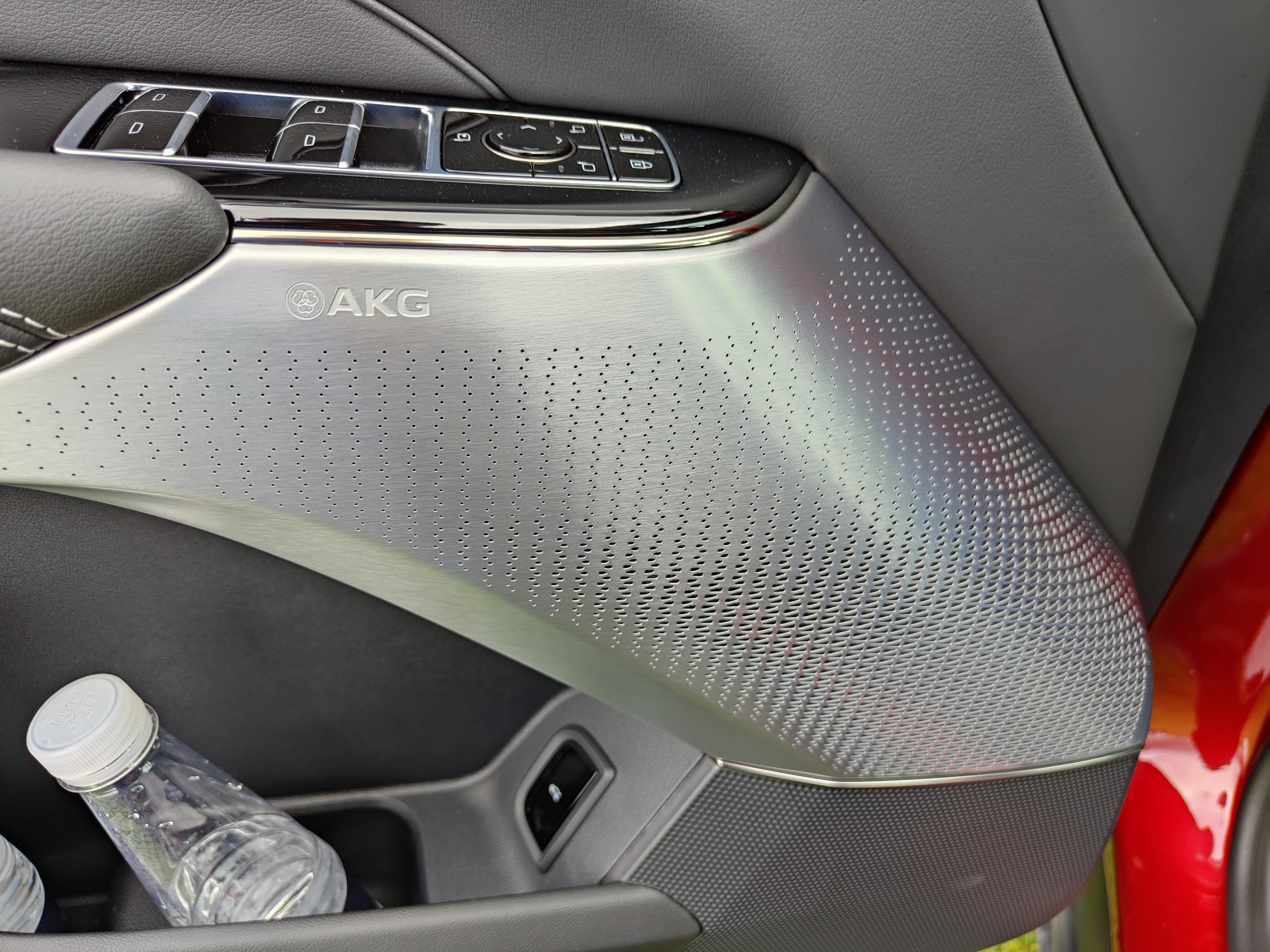
The front air conditioning vent is physically adjustable, but unlike conventional direct-adjustment vents, LYRIQ is controlled by a crystal-operated lever next to the vent. Below the vent, there is still a row of physical switches that are not often used, just like in a gasoline-powered car.
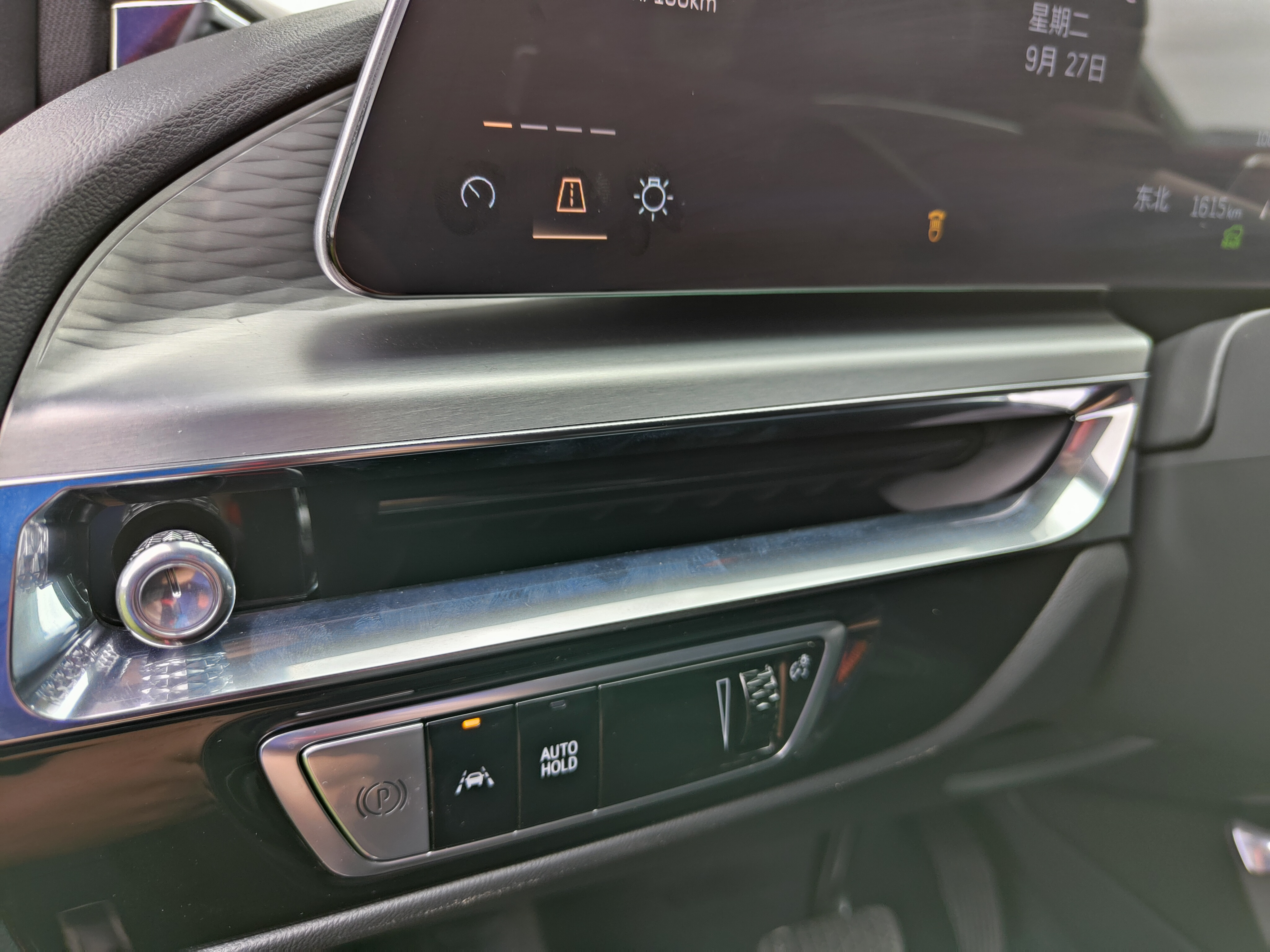
The instrument panel and central control are connected to a 9K resolution screen with a PPI of 271 and a maximum brightness of 850 nits and a color depth of 10 bits, and all parameters are top-notch. The instrument panel can also be touched, and users can customize different instrument display modes.
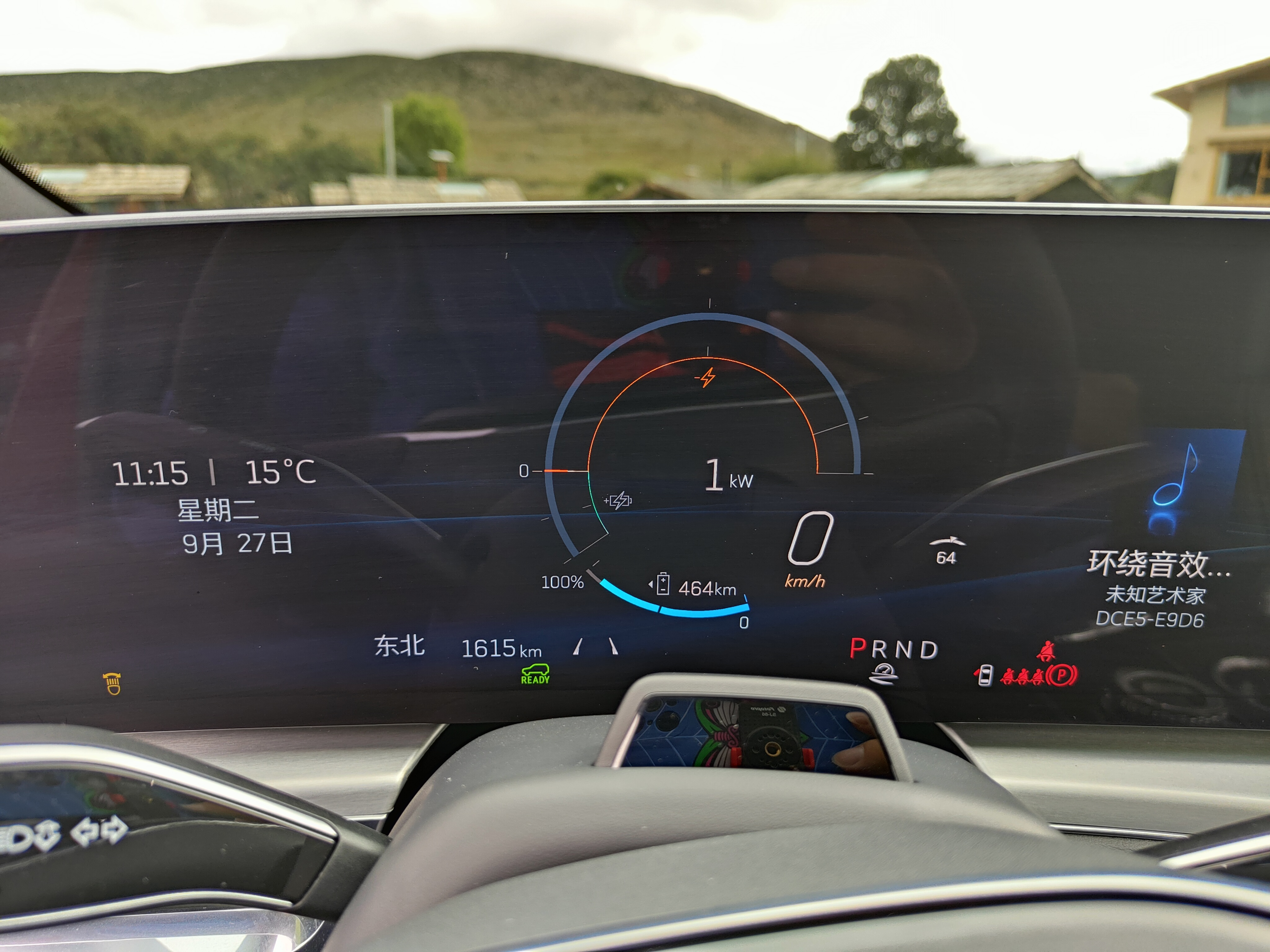
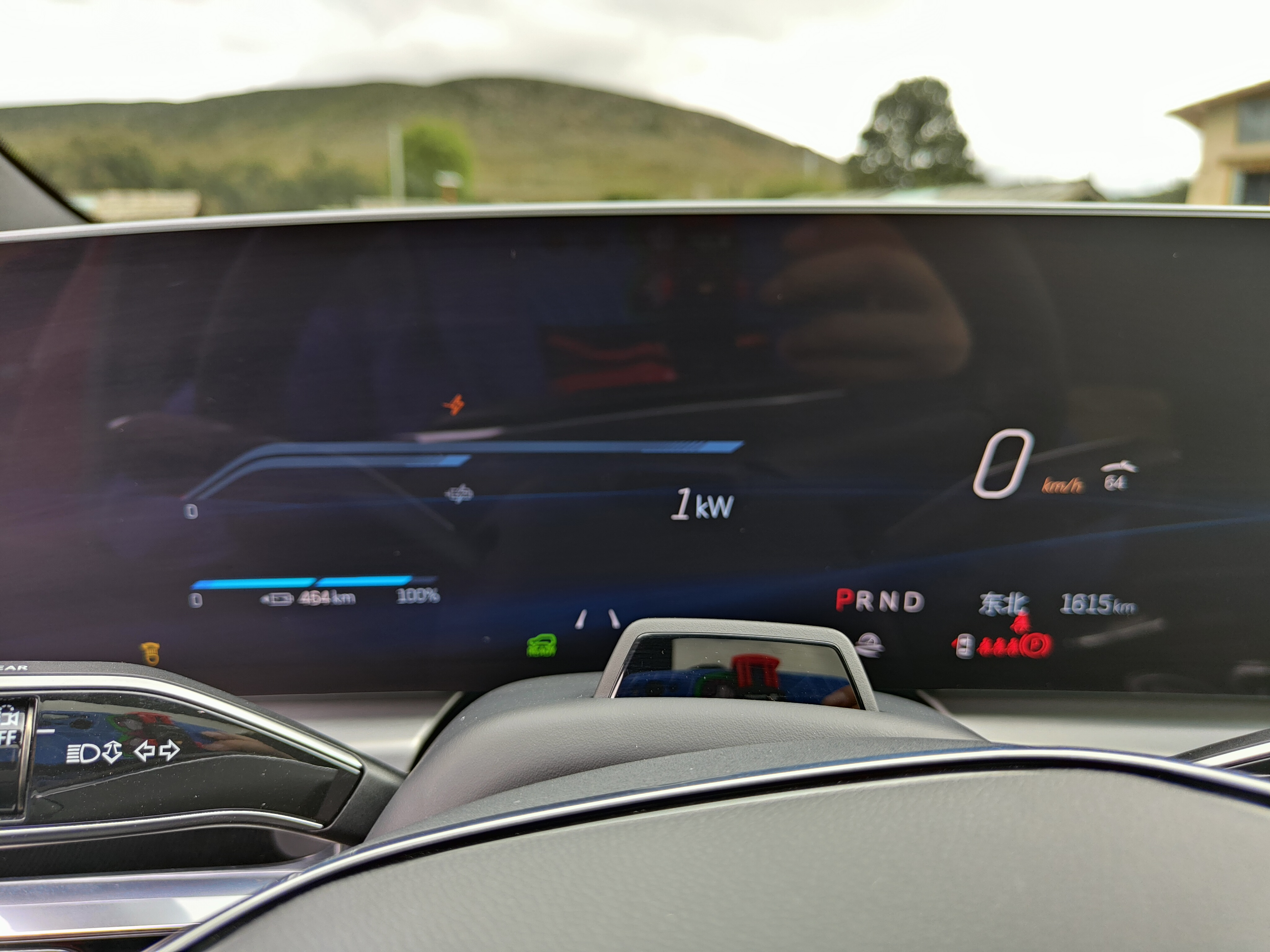
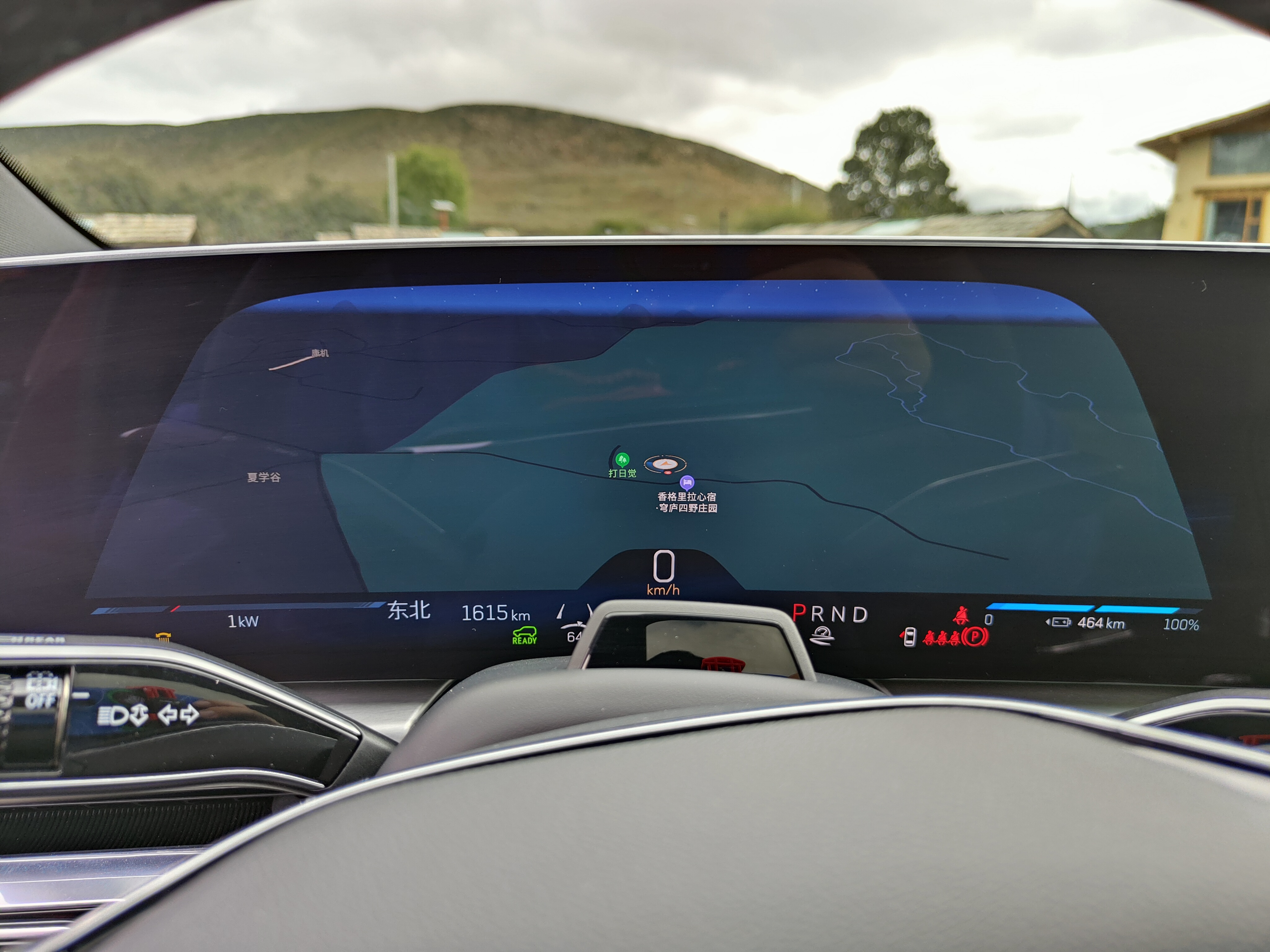
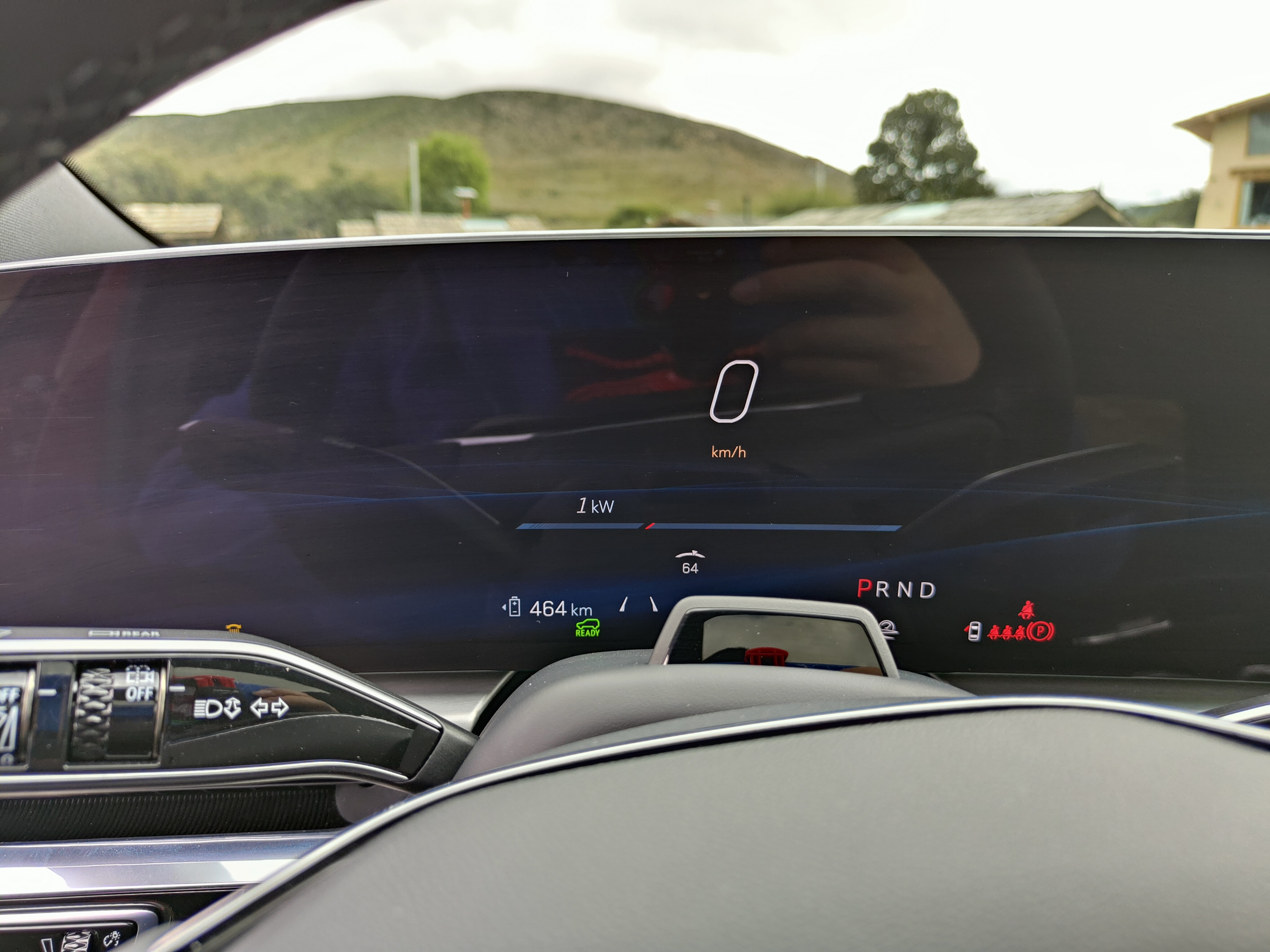
The central control is almost the same size as the instrument panel, and the vehicle’s machine is relatively smooth and has no obvious card lag, but compared to other 8155 models, it is relatively basic. Additionally, users need to get familiar with the system menu to find corresponding functions.
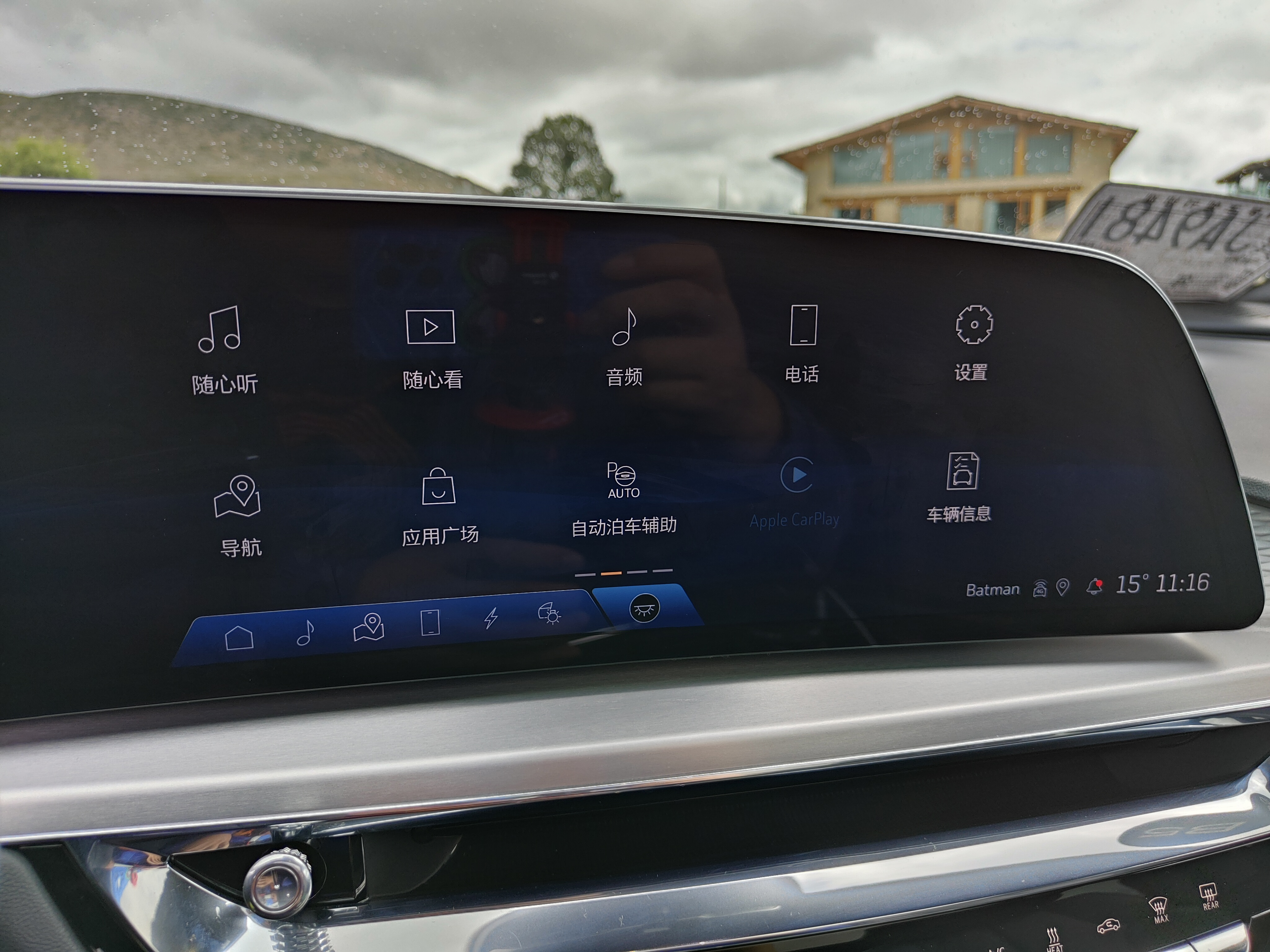
The central armrest area retains the commonly used control area, where the knob is not used to control multimedia volume, but to replace the central control screen’s touch operation, similar to a “mouse.”
Open the armrest, which is about the depth of a bottle of mineral water, but the overall space is not large. There is a USB-A port and a car fast charging interface inside, and the USB-C port is placed outside the armrest, next to the wireless charging slot for mobile phones.

The armrest has a hollowed-out design with a large storage space. Women’s high heels, handbags, and men’s leather shoes can all be placed here.
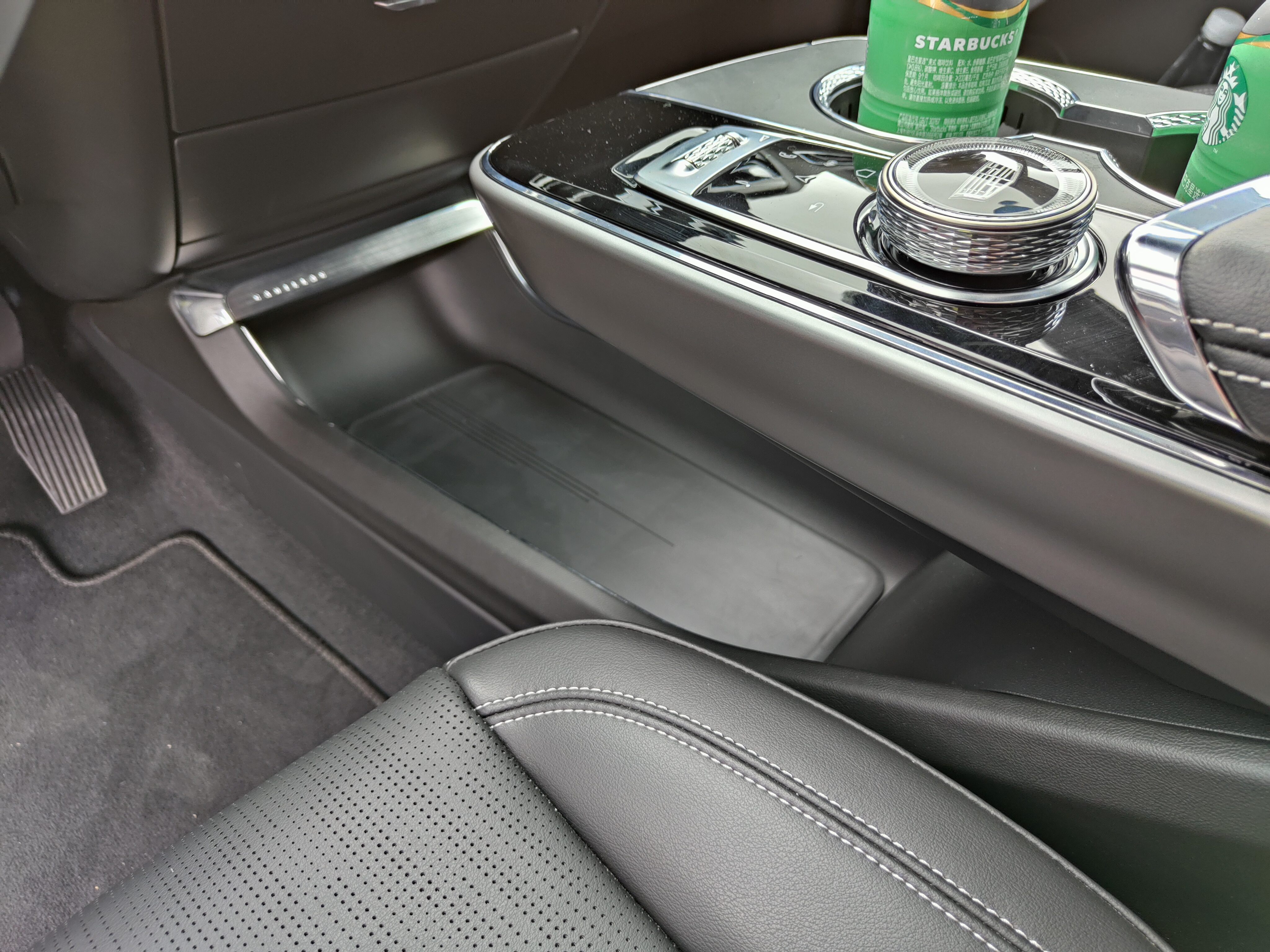
Under the center console, there is a row of air conditioning control buttons reserved, and there are two small drawers for placing small objects such as tickets.
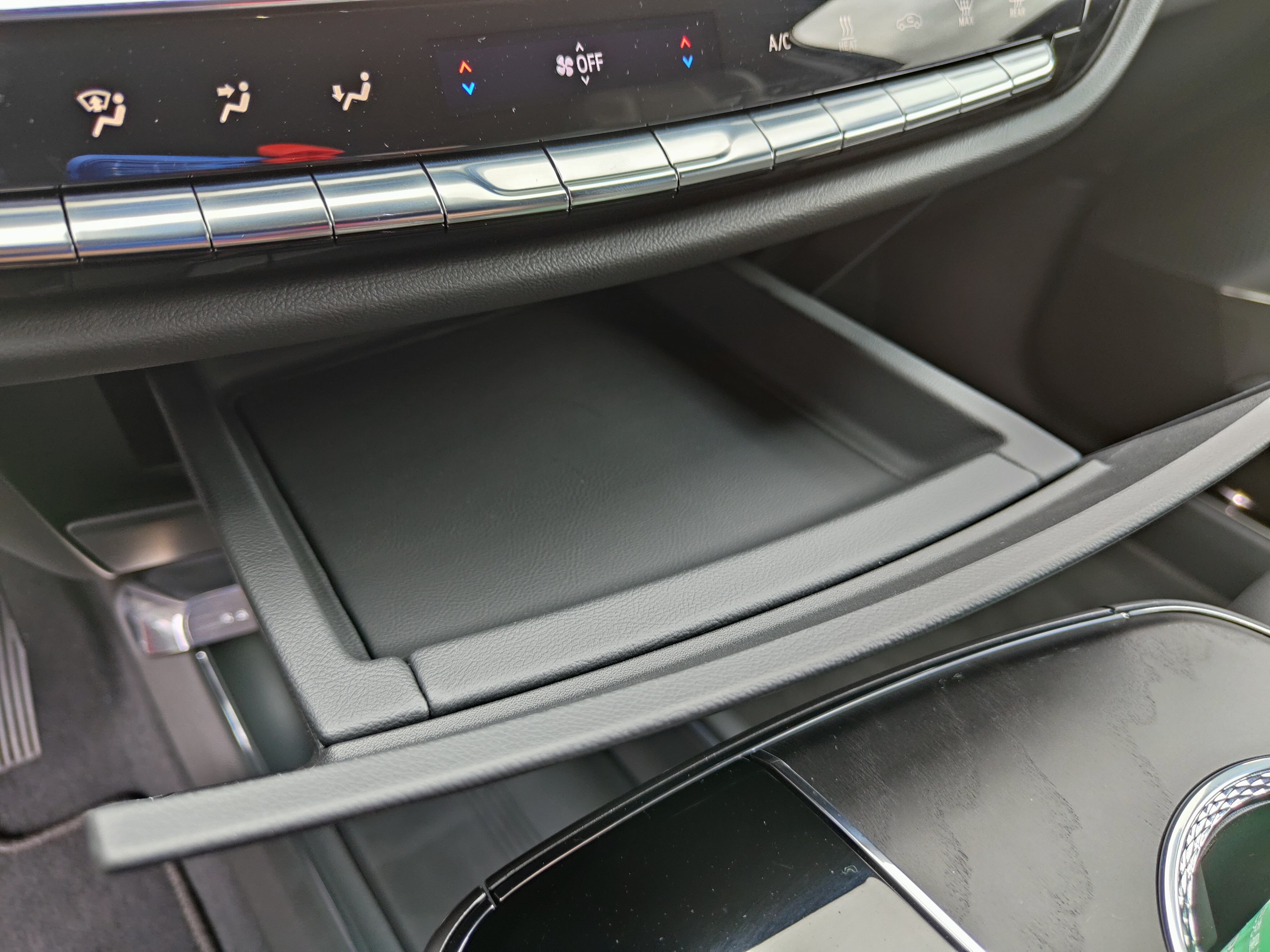
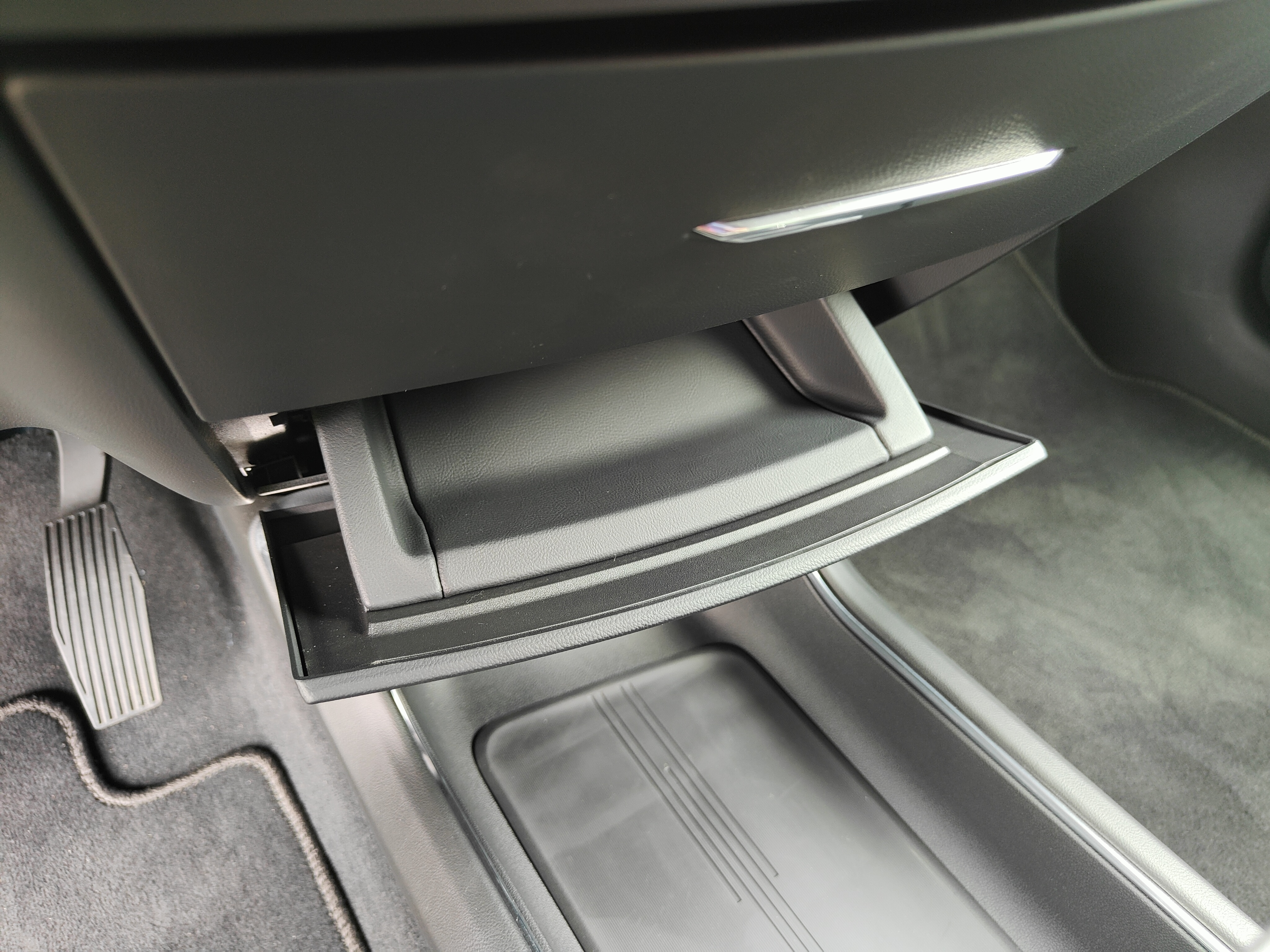
Both front headrests have speakers, so you can listen to music without disturbing other passengers in the car.

The car roof uses a panoramic glass roof with an electric sunshade. It should be noted that the car model photographed this time is the rear-drive long-endurance luxury version. If it is the premium version, there are two skylights that can be opened, supporting the opening of the front half.
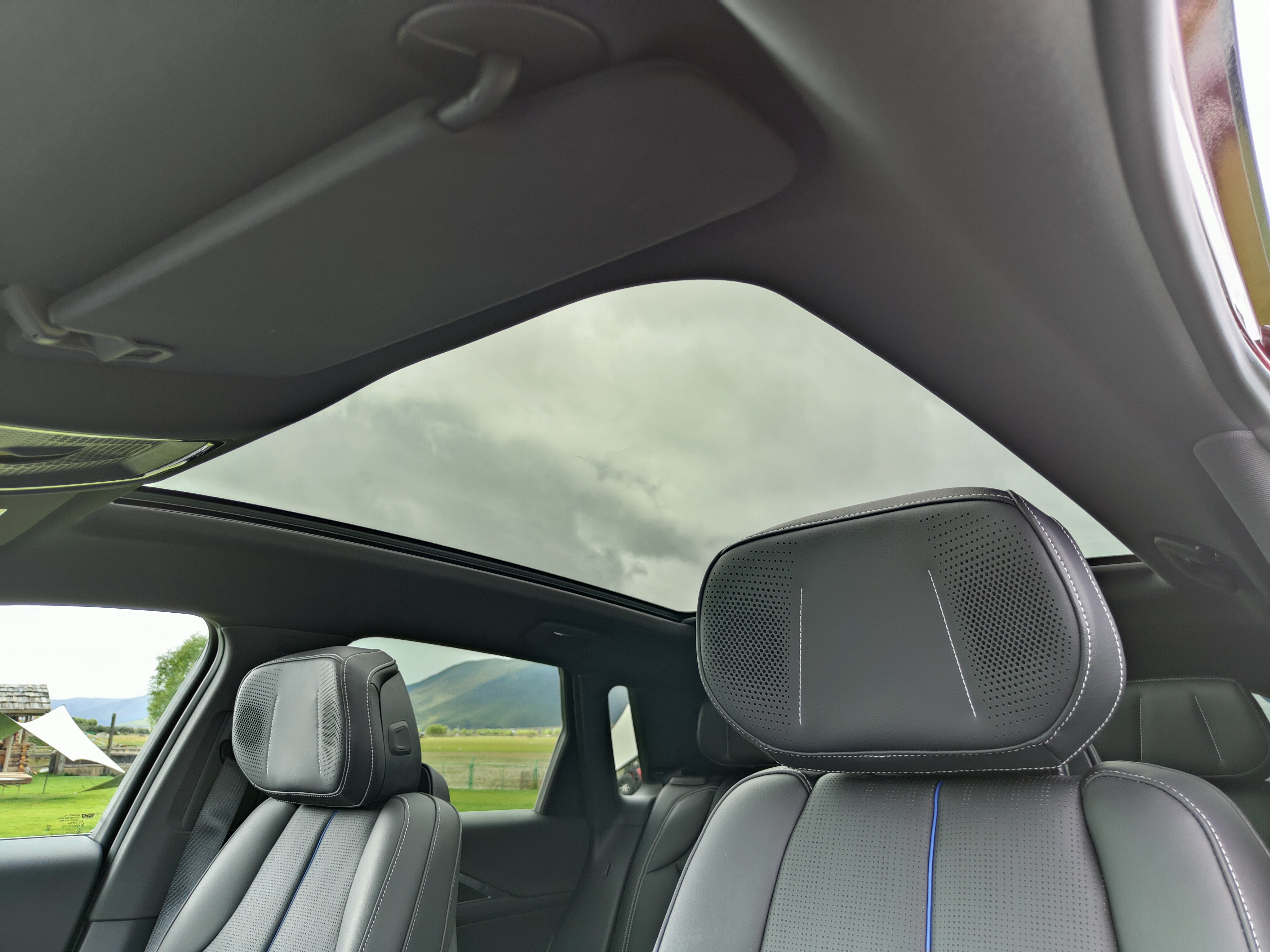
As for the rear space that everyone is concerned about, I tested it myself. I am 176 cm tall and the front seat is in a suitable sitting position for me. There is enough legroom, about two fists and two fingers to the left and right, but when leaning back completely against the seat back, there are only two fingers of headroom.


There are two air outlets, two USB-C ports and a storage slot behind the armrest in the rear seat, but I tried to put my phone in and it couldn’t fit.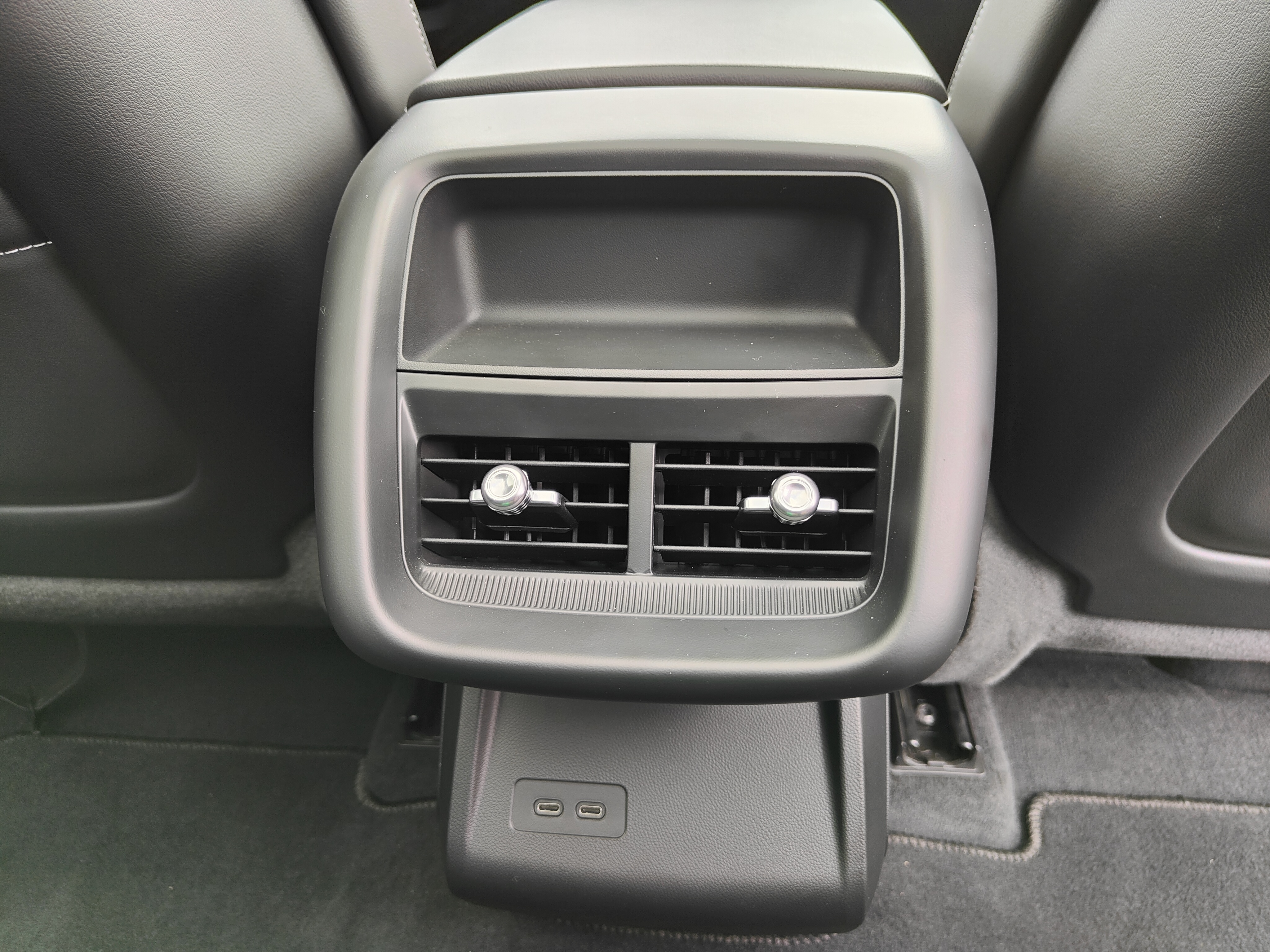
There are only two cup holders in the rear armrest, which is also the reason for the relatively soft backrest of the middle seat.

That’s all about the interior. Since this is a test drive event, let’s talk about the performance of the car after driving it.
Dynamic Test Drive
As usual, let’s start with the model. The model we test drive this time is the rear-wheel drive luxury version of the Cadillac LYRIQ. All driving experiences can only represent this model. The first batch of deliveries in October include the rear-wheel drive luxury version and premium version, while the four-wheel drive version needs to wait.
Since the test drive location is in Shangri-La, Yunnan, the road conditions are not very good. Most of the roads are narrow two-lane roads, and the local speed limits are strictly enforced. Therefore, the average maximum speed of the test drive does not exceed 60 km/h.
Let’s first take a look at the energy consumption performance of a segment of road. For a mid-size SUV with a length of 5 meters, this energy consumption is quite good.
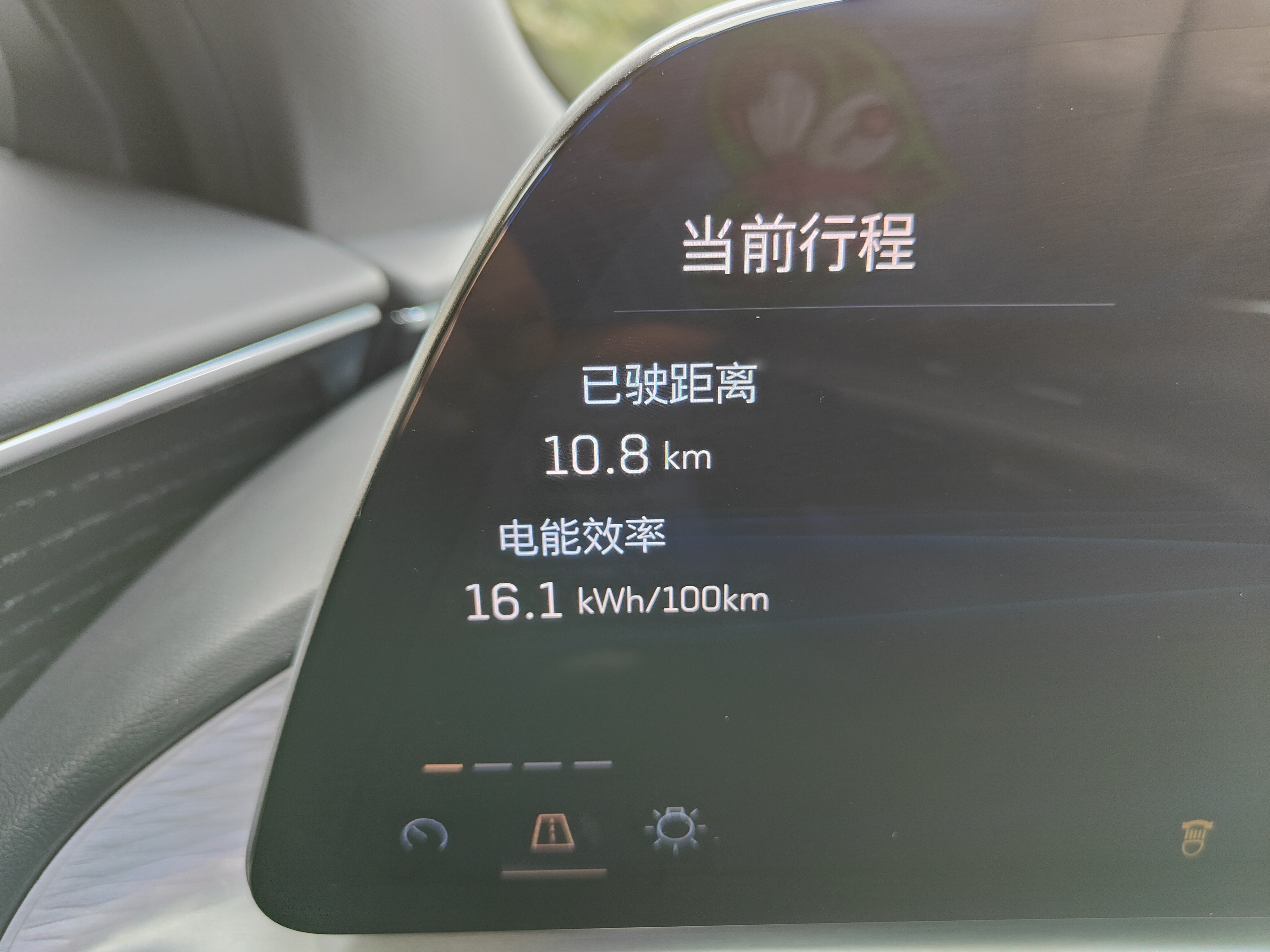
LYRIQ has three driving modes: travel, sport, and custom. In travel mode, the car is relatively easy to drive, but the steering wheel feels light, which I personally don’t like. After switching to sport mode, the steering wheel feels more moderate.
No matter which mode, LYRIQ’s power output is relatively linear, and stepping on the accelerator pedal won’t give you a feeling of jolt. By default, there is no kinetic energy recovery. You need to use the kinetic energy recovery paddles on the left side of the steering wheel or turn on the one-pedal driving mode to achieve it. The custom mode also supports adjusting the feedback intensity of the brakes.
Let’s talk about LYRIQ’s one-pedal driving mode. When it is turned on in travel mode, the sensation is completely different from Tesla’s one-pedal driving. Tesla feels like you have stepped on the brake when you release the pedal, while LYRIQ only adds light kinetic energy recovery in normal mode and has the function of stopping the car when releasing the pedal to 0 km/h.
Since I don’t turn on one-pedal driving mode even when driving Tesla myself, I refused to try it when the coach first suggested it. But after actually turning it on, I found that this is the true one-pedal driving mode I really want, with smooth and linear deceleration and support for stopping.
Next, let’s talk about the kinetic energy recovery paddles, which can be used regardless of whether the one-pedal driving mode is turned on. You can get some braking force by tilting it towards the driver’s side, and when it is tilted to the maximum, it feels like stepping on the brake, which can be understood as another type of “handbrake”.# Competing Products
When it comes to the popular SUV models in the 300,000-500,000 RMB range, what comes to mind? Share your thoughts in the comments below.
For me, the first that comes to mind is the flagship SUV model by XPeng Motors, the XPeng G9, as well as the NIO ES7, and the Li Xiang L9. In addition, I would also like to include the Avatar 11.
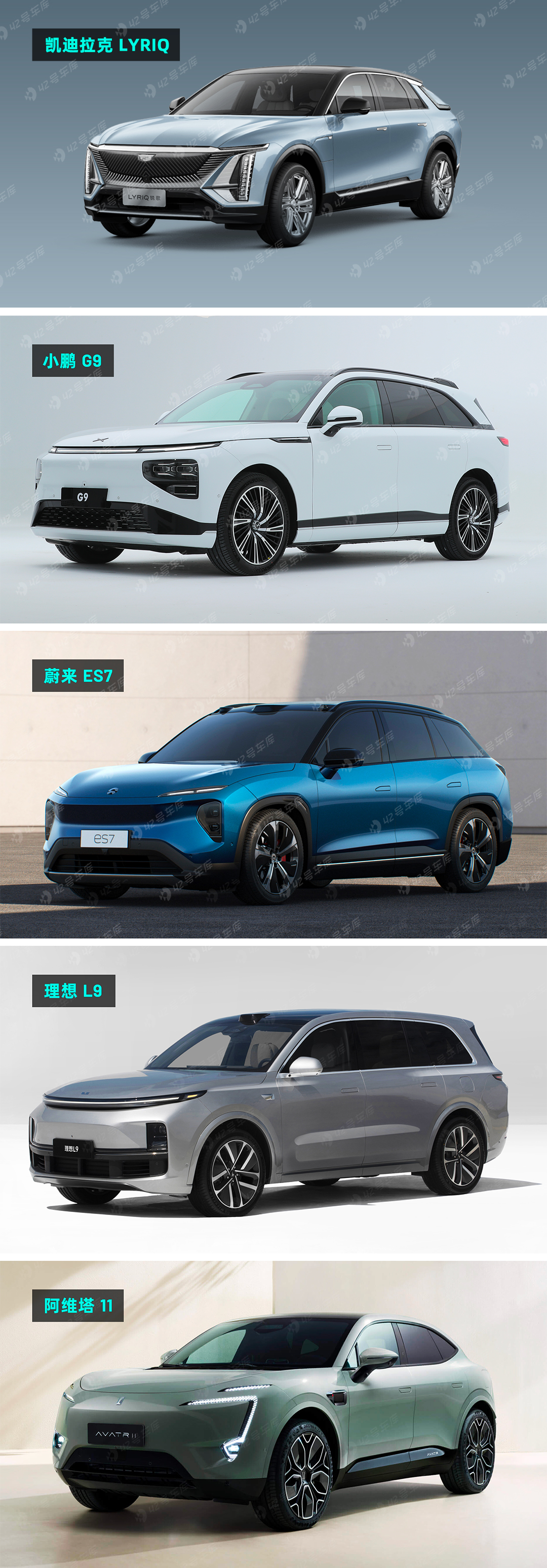
I have compiled the appearance and interior design of these cars for you. Which one do you like the most?
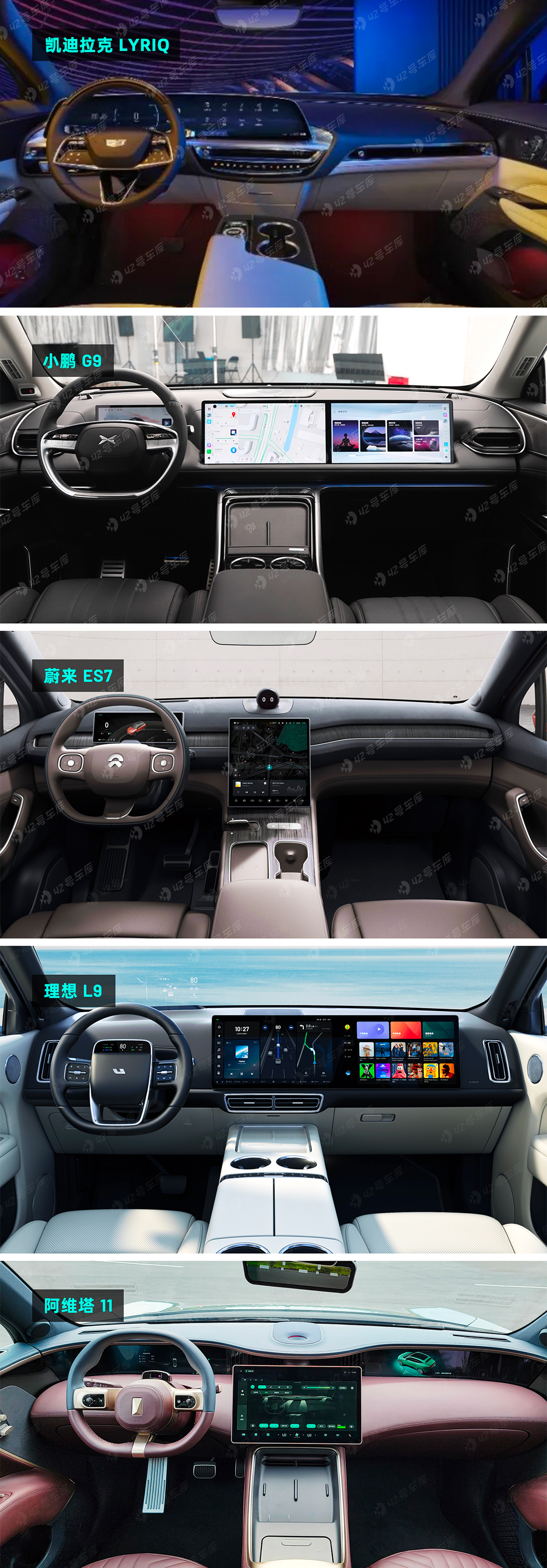
From the pictures, we can see that each manufacturer has a different interpretation of luxury interior design. The Li Xiang L9 replaces the main driver instrument screen with a small-sized steering wheel interaction touch screen and a large-sized HUD, while the NIO ES7 also features a HUD function. The XPeng G9, Li Xiang L9, and Avatar 11 also have a passenger screen for entertainment, whereas the other three models do not.
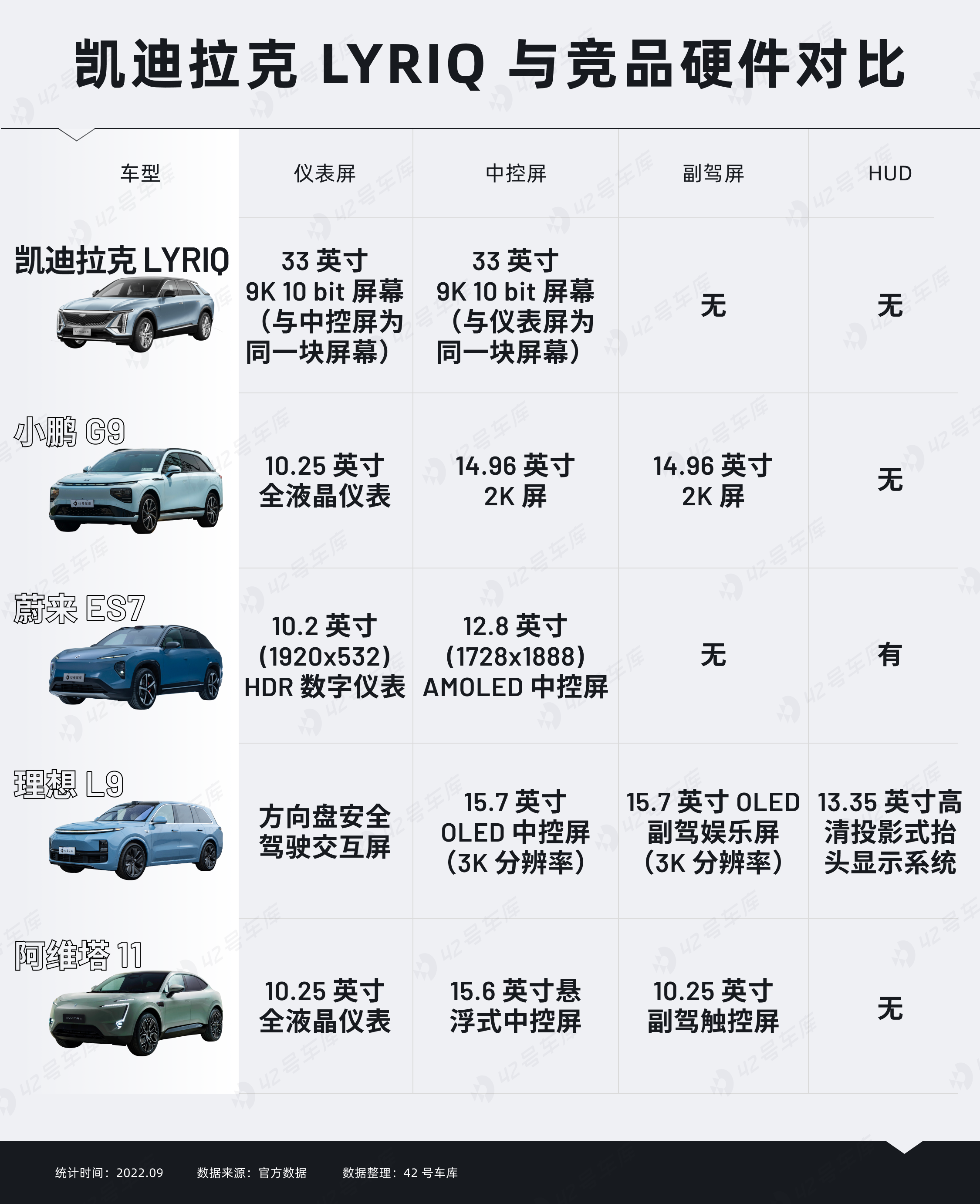
Overall, while the Cadillac LYRIQ performs well, it certainly has some tough competition.The seat configurations are shown in the following figure. Except for the IDEAL L9, all other models are 5-seater SUVs. The IDEAL L9 has the most abundant seat configuration. The 4-seater versions of XPeng G9, NIO ES7, and AVITA 11 are also luxurious. However, the rear seats of the 5-seater version of AVITA can only adjust the angle. In comparison, the rear seat configuration of LYRIQ is not as luxurious.
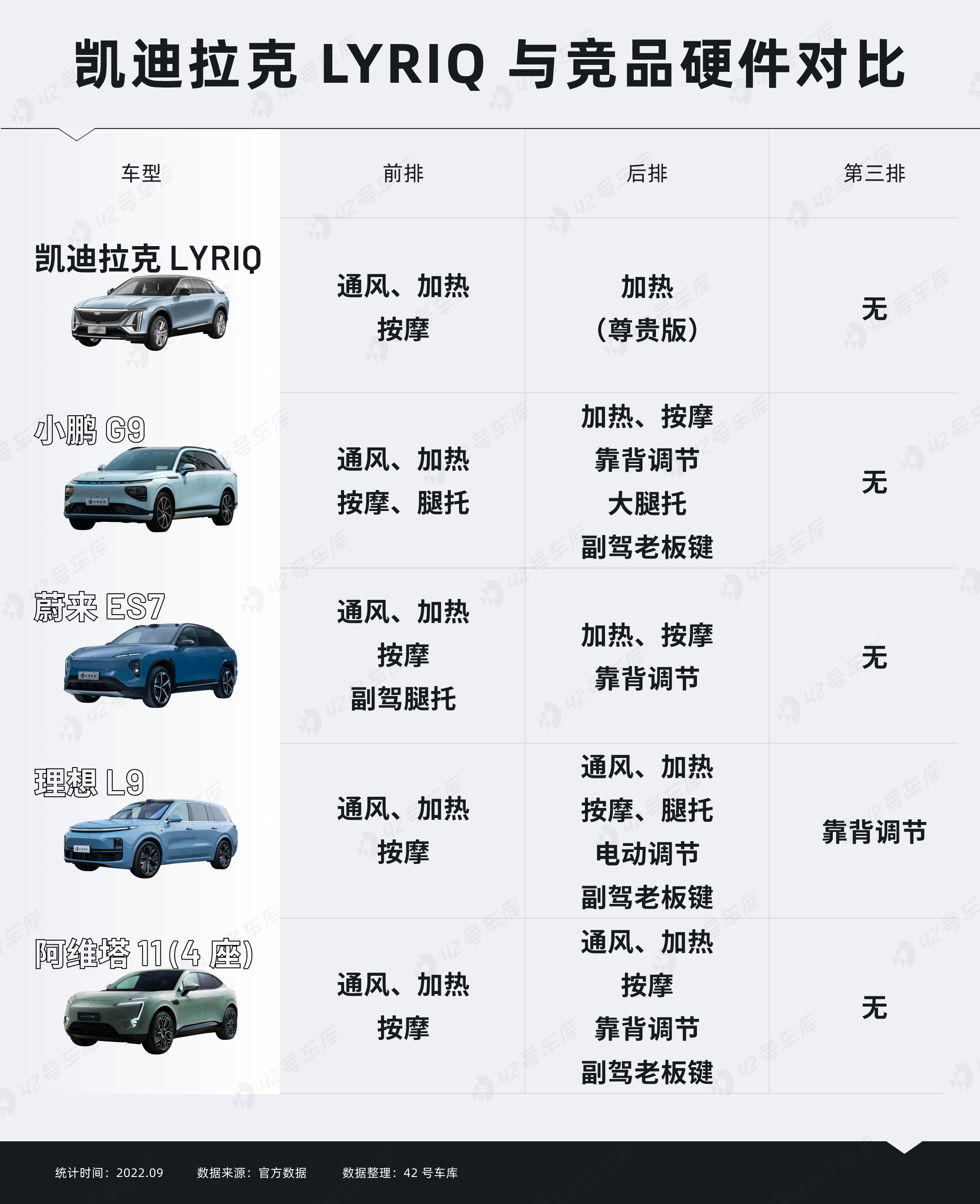
In terms of power, the acceleration of four-wheel-drive versions of three cars is within 4 seconds per 100 kilometers, which is the level of a sporty SUV. The four-wheel-drive version of Cadillac LYRIQ also has a 4.9-second acceleration, which is also a very good power level. Due to the full-size 6-seater SUV, the acceleration of 5.3 seconds per 100 kilometers of IDEAL L9 is still strong among SUVs of the same level.
When it comes to luxury cars, the audio system is always a configuration that can’t be ignored. As shown in the figure below, the audio power of XPeng G9 and IDEAL L9 is the highest, and LYRIQ and NIO ES7 are not much inferior. In comparison, AVITA 11 is slightly inferior in audio, but RNC active noise reduction is one of its highlights.
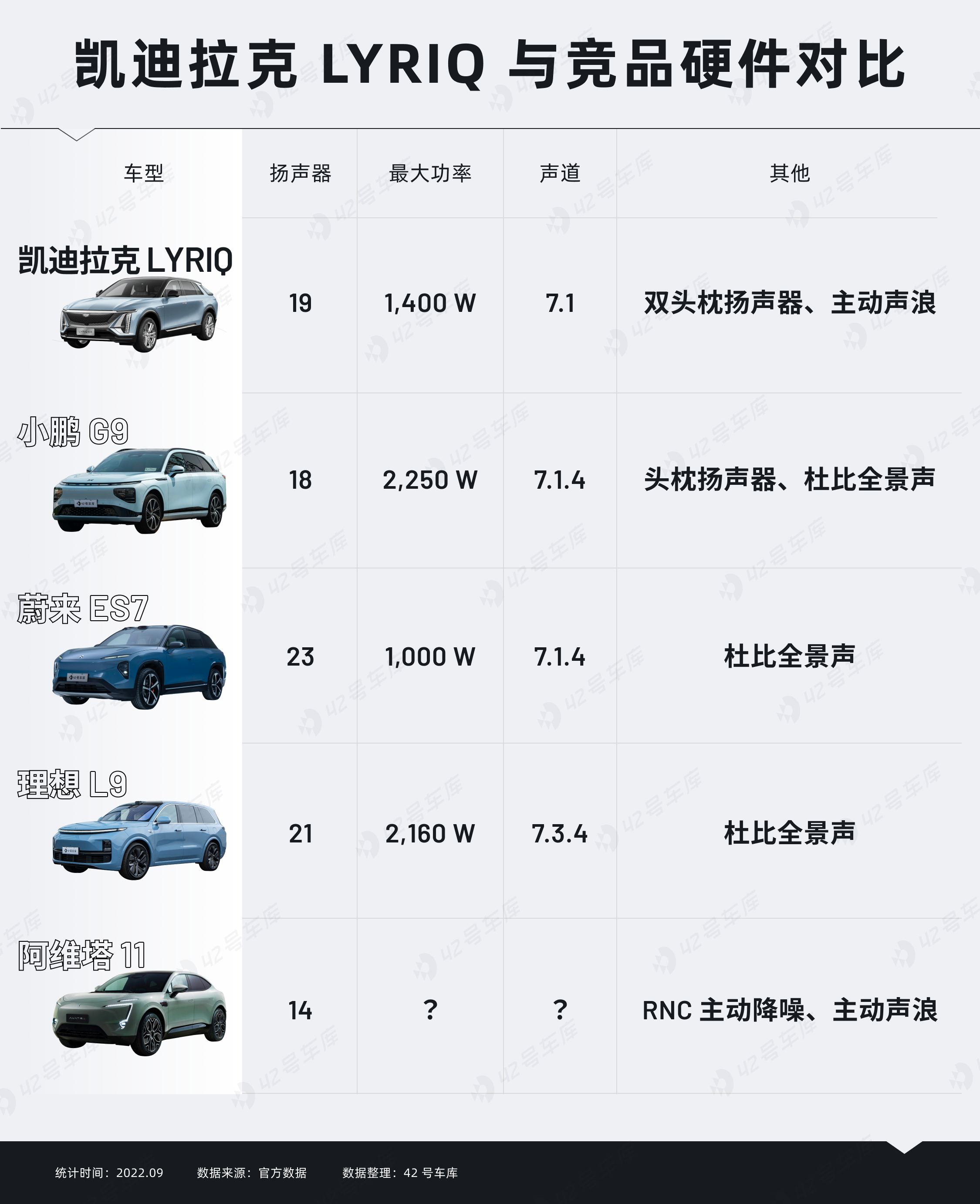
In summary, Cadillac has indeed produced good configurations on LYRIQ in this price range. However, due to the severe “internal competition” among domestic luxury SUVs in this price range, many LYRIQ configurations are not only not superior to competitors but also slightly inferior.
In conclusion
On September 28th, Cadillac LYRIQ was officially transported from SAIC-GM Cadillac Factory to all parts of the country, and this car with the pre-sale price announced half a year ago is finally about to be delivered.
However, the domestic luxury new energy SUV market is no longer the same as it was in November last year. Opponents in the 400,000 price range no longer include just NIO, but also include XPeng, IDEAL, and AVITA, a new player.
In terms of configuration, localization system, and assisted driving, LYRIQ does not have an advantage over its domestic opponents. Being unable to compete with domestic opponents regarding product configuration at the same price is also a major dilemma faced by all joint venture brands.
For Cadillac’s old car owners, LYRIQ still has that familiar taste. If they want to buy a pure electric car, LYRIQ may indeed be their preferred choice.
But for other users who want to buy a luxury new energy medium-to-large SUV, the current choice is simply too many.
This article is a translation by ChatGPT of a Chinese report from 42HOW. If you have any questions about it, please email bd@42how.com.
